Loading AI tools
From Wikipedia, the free encyclopedia
In the field of hyperbolic geometry, the order-4 hexagonal tiling honeycomb arises as one of 11 regular paracompact honeycombs in 3-dimensional hyperbolic space. It is paracompact because it has cells composed of an infinite number of faces. Each cell is a hexagonal tiling whose vertices lie on a horosphere: a flat plane in hyperbolic space that approaches a single ideal point at infinity.
| Order-4 hexagonal tiling honeycomb | |
|---|---|
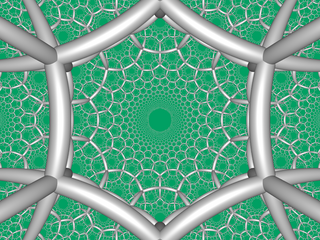 Perspective projection view within Poincaré disk model | |
| Type | Hyperbolic regular honeycomb Paracompact uniform honeycomb |
| Schläfli symbols | {6,3,4} {6,31,1} t0,1{(3,6)2} |
| Coxeter diagrams |  ↔ ↔ |
| Cells | {6,3} |
| Faces | hexagon {6} |
| Edge figure | square {4} |
| Vertex figure |  octahedron |
| Dual | Order-6 cubic honeycomb |
| Coxeter groups | , [4,3,6] , [6,31,1] , [(6,3)[2]] |
| Properties | Regular, quasiregular |
A geometric honeycomb is a space-filling of polyhedral or higher-dimensional cells, so that there are no gaps. It is an example of the more general mathematical tiling or tessellation in any number of dimensions.
Honeycombs are usually constructed in ordinary Euclidean ("flat") space, like the convex uniform honeycombs. They may also be constructed in non-Euclidean spaces, such as hyperbolic uniform honeycombs. Any finite uniform polytope can be projected to its circumsphere to form a uniform honeycomb in spherical space.
The Schläfli symbol of the order-4 hexagonal tiling honeycomb is {6,3,4}. Since that of the hexagonal tiling is {6,3}, this honeycomb has four such hexagonal tilings meeting at each edge. Since the Schläfli symbol of the octahedron is {3,4}, the vertex figure of this honeycomb is an octahedron. Thus, eight hexagonal tilings meet at each vertex of this honeycomb, and the six edges meeting at each vertex lie along three orthogonal axes.[1]
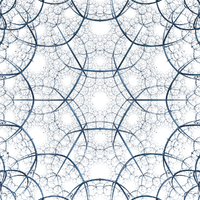 Perspective projection |
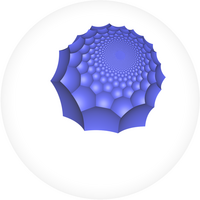 One cell, viewed from outside the Poincare sphere |
 The vertices of a t{(3,∞,3)}, |
 The honeycomb is analogous to the H2 order-4 apeirogonal tiling, {∞,4}, shown here with one green apeirogon outlined by its horocycle |
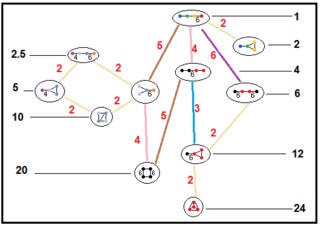
The order-4 hexagonal tiling honeycomb has three reflective simplex symmetry constructions.
The half-symmetry uniform construction {6,31,1} has two types (colors) of hexagonal tilings, with Coxeter diagram ![]()
![]()
![]()
![]()
![]()
![]()
![]() ↔
↔ ![]()
![]()
![]()
![]()
![]() . A quarter-symmetry construction also exists, with four colors of hexagonal tilings:
. A quarter-symmetry construction also exists, with four colors of hexagonal tilings: ![]()
![]()
![]()
![]()
![]() .
.
An additional two reflective symmetries exist with non-simplectic fundamental domains: [6,3*,4], which is index 6, with Coxeter diagram ![]()
![]()
![]()
![]()
![]()
![]()
![]() ; and [6,(3,4)*], which is index 48. The latter has a cubic fundamental domain, and an octahedral Coxeter diagram with three axial infinite branches:
; and [6,(3,4)*], which is index 48. The latter has a cubic fundamental domain, and an octahedral Coxeter diagram with three axial infinite branches:  . It can be seen as using eight colors to color the hexagonal tilings of the honeycomb.
. It can be seen as using eight colors to color the hexagonal tilings of the honeycomb.
The order-4 hexagonal tiling honeycomb contains ![]()
![]()
![]()
![]()
![]() , which tile 2-hypercycle surfaces and are similar to the truncated infinite-order triangular tiling,
, which tile 2-hypercycle surfaces and are similar to the truncated infinite-order triangular tiling, ![]()
![]()
![]()
![]()
![]() :
:
The order-4 hexagonal tiling honeycomb is a regular hyperbolic honeycomb in 3-space, and one of 11 which are paracompact.
There are fifteen uniform honeycombs in the [6,3,4] Coxeter group family, including this regular form, and its dual, the order-6 cubic honeycomb.
| [6,3,4] family honeycombs | |||||||||||
|---|---|---|---|---|---|---|---|---|---|---|---|
| {6,3,4} | r{6,3,4} | t{6,3,4} | rr{6,3,4} | t0,3{6,3,4} | tr{6,3,4} | t0,1,3{6,3,4} | t0,1,2,3{6,3,4} | ||||
 |
 |
 |
 |
 |
 |
 |
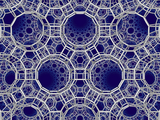 | ||||
 |
 |
 |
 |
 |
 |
 | |||||
| {4,3,6} | r{4,3,6} | t{4,3,6} | rr{4,3,6} | 2t{4,3,6} | tr{4,3,6} | t0,1,3{4,3,6} | t0,1,2,3{4,3,6} | ||||
The order-4 hexagonal tiling honeycomb has a related alternated honeycomb, ![]()
![]()
![]()
![]()
![]()
![]()
![]() ↔
↔ ![]()
![]()
![]()
![]()
![]() , with triangular tiling and octahedron cells.
, with triangular tiling and octahedron cells.
It is a part of sequence of regular honeycombs of the form {6,3,p}, all of which are composed of hexagonal tiling cells:
This honeycomb is also related to the 16-cell, cubic honeycomb and order-4 dodecahedral honeycomb, all of which have octahedral vertex figures.
The aforementioned honeycombs are also quasiregular:
| Rectified order-4 hexagonal tiling honeycomb | |
|---|---|
| Type | Paracompact uniform honeycomb |
| Schläfli symbols | r{6,3,4} or t1{6,3,4} |
| Coxeter diagrams | |
| Cells | {3,4} r{6,3} |
| Faces | triangle {3} hexagon {6} |
| Vertex figure |  square prism |
| Coxeter groups | , [4,3,6] , [4,3[3]] , [6,31,1] , [3[]×[]] |
| Properties | Vertex-transitive, edge-transitive |
The rectified order-4 hexagonal tiling honeycomb, t1{6,3,4}, ![]()
![]()
![]()
![]()
![]()
![]()
![]() has octahedral and trihexagonal tiling facets, with a square prism vertex figure.
has octahedral and trihexagonal tiling facets, with a square prism vertex figure.
It is similar to the 2D hyperbolic tetraapeirogonal tiling, r{∞,4}, ![]()
![]()
![]()
![]()
![]() which alternates apeirogonal and square faces:
which alternates apeirogonal and square faces:
| Truncated order-4 hexagonal tiling honeycomb | |
|---|---|
| Type | Paracompact uniform honeycomb |
| Schläfli symbol | t{6,3,4} or t0,1{6,3,4} |
| Coxeter diagram | |
| Cells | {3,4} t{6,3} |
| Faces | triangle {3} dodecagon {12} |
| Vertex figure |  square pyramid |
| Coxeter groups | , [4,3,6] , [6,31,1] |
| Properties | Vertex-transitive |
The truncated order-4 hexagonal tiling honeycomb, t0,1{6,3,4}, ![]()
![]()
![]()
![]()
![]()
![]()
![]() has octahedron and truncated hexagonal tiling facets, with a square pyramid vertex figure.
has octahedron and truncated hexagonal tiling facets, with a square pyramid vertex figure.
It is similar to the 2D hyperbolic truncated order-4 apeirogonal tiling, t{∞,4}, ![]()
![]()
![]()
![]()
![]() with apeirogonal and square faces:
with apeirogonal and square faces:
| Bitruncated order-4 hexagonal tiling honeycomb | |
|---|---|
| Type | Paracompact uniform honeycomb |
| Schläfli symbol | 2t{6,3,4} or t1,2{6,3,4} |
| Coxeter diagram | |
| Cells | t{4,3} t{3,6} |
| Faces | square {4} hexagon {6} |
| Vertex figure |  digonal disphenoid |
| Coxeter groups | , [4,3,6] , [4,3[3]] , [6,31,1] , [3[]×[]] |
| Properties | Vertex-transitive |
The bitruncated order-4 hexagonal tiling honeycomb, t1,2{6,3,4}, ![]()
![]()
![]()
![]()
![]()
![]()
![]() has truncated octahedron and hexagonal tiling cells, with a digonal disphenoid vertex figure.
has truncated octahedron and hexagonal tiling cells, with a digonal disphenoid vertex figure.
| Cantellated order-4 hexagonal tiling honeycomb | |
|---|---|
| Type | Paracompact uniform honeycomb |
| Schläfli symbol | rr{6,3,4} or t0,2{6,3,4} |
| Coxeter diagram | |
| Cells | r{3,4} {}x{4} rr{6,3} |
| Faces | triangle {3} square {4} hexagon {6} |
| Vertex figure |  wedge |
| Coxeter groups | , [4,3,6] , [6,31,1] |
| Properties | Vertex-transitive |
The cantellated order-4 hexagonal tiling honeycomb, t0,2{6,3,4}, ![]()
![]()
![]()
![]()
![]()
![]()
![]() has cuboctahedron, cube, and rhombitrihexagonal tiling cells, with a wedge vertex figure.
has cuboctahedron, cube, and rhombitrihexagonal tiling cells, with a wedge vertex figure.
| Cantitruncated order-4 hexagonal tiling honeycomb | |
|---|---|
| Type | Paracompact uniform honeycomb |
| Schläfli symbol | tr{6,3,4} or t0,1,2{6,3,4} |
| Coxeter diagram | |
| Cells | t{3,4} {}x{4} tr{6,3} |
| Faces | square {4} hexagon {6} dodecagon {12} |
| Vertex figure |  mirrored sphenoid |
| Coxeter groups | , [4,3,6] , [6,31,1] |
| Properties | Vertex-transitive |
The cantitruncated order-4 hexagonal tiling honeycomb, t0,1,2{6,3,4}, ![]()
![]()
![]()
![]()
![]()
![]()
![]() has truncated octahedron, cube, and truncated trihexagonal tiling cells, with a mirrored sphenoid vertex figure.
has truncated octahedron, cube, and truncated trihexagonal tiling cells, with a mirrored sphenoid vertex figure.
| Runcinated order-4 hexagonal tiling honeycomb | |
|---|---|
| Type | Paracompact uniform honeycomb |
| Schläfli symbol | t0,3{6,3,4} |
| Coxeter diagram | |
| Cells | {4,3} {}x{4} {6,3} {}x{6} |
| Faces | square {4} hexagon {6} |
| Vertex figure |  irregular triangular antiprism |
| Coxeter groups | , [4,3,6] |
| Properties | Vertex-transitive |
The runcinated order-4 hexagonal tiling honeycomb, t0,3{6,3,4}, ![]()
![]()
![]()
![]()
![]()
![]()
![]() has cube, hexagonal tiling and hexagonal prism cells, with an irregular triangular antiprism vertex figure.
has cube, hexagonal tiling and hexagonal prism cells, with an irregular triangular antiprism vertex figure.
It contains the 2D hyperbolic rhombitetrahexagonal tiling, rr{4,6}, ![]()
![]()
![]()
![]()
![]() with square and hexagonal faces. The tiling also has a half symmetry construction
with square and hexagonal faces. The tiling also has a half symmetry construction ![]()
![]()
![]() .
.
| Runcitruncated order-4 hexagonal tiling honeycomb | |
|---|---|
| Type | Paracompact uniform honeycomb |
| Schläfli symbol | t0,1,3{6,3,4} |
| Coxeter diagram | |
| Cells | rr{3,4} {}x{4} {}x{12} t{6,3} |
| Faces | triangle {3} square {4} dodecagon {12} |
| Vertex figure | isosceles-trapezoidal pyramid |
| Coxeter groups | , [4,3,6] |
| Properties | Vertex-transitive |
The runcitruncated order-4 hexagonal tiling honeycomb, t0,1,3{6,3,4}, ![]()
![]()
![]()
![]()
![]()
![]()
![]() has rhombicuboctahedron, cube, dodecagonal prism, and truncated hexagonal tiling cells, with an isosceles-trapezoidal pyramid vertex figure.
has rhombicuboctahedron, cube, dodecagonal prism, and truncated hexagonal tiling cells, with an isosceles-trapezoidal pyramid vertex figure.
The runcicantellated order-4 hexagonal tiling honeycomb is the same as the runcitruncated order-6 cubic honeycomb.
| Omnitruncated order-4 hexagonal tiling honeycomb | |
|---|---|
| Type | Paracompact uniform honeycomb |
| Schläfli symbol | t0,1,2,3{6,3,4} |
| Coxeter diagram | |
| Cells | tr{4,3} tr{6,3} {}x{12} {}x{8} |
| Faces | square {4} hexagon {6} octagon {8} dodecagon {12} |
| Vertex figure |  irregular tetrahedron |
| Coxeter groups | , [4,3,6] |
| Properties | Vertex-transitive |
The omnitruncated order-4 hexagonal tiling honeycomb, t0,1,2,3{6,3,4}, ![]()
![]()
![]()
![]()
![]()
![]()
![]() has truncated cuboctahedron, truncated trihexagonal tiling, dodecagonal prism, and octagonal prism cells, with an irregular tetrahedron vertex figure.
has truncated cuboctahedron, truncated trihexagonal tiling, dodecagonal prism, and octagonal prism cells, with an irregular tetrahedron vertex figure.
| Alternated order-4 hexagonal tiling honeycomb | |
|---|---|
| Type | Paracompact uniform honeycomb Semiregular honeycomb |
| Schläfli symbols | h{6,3,4} |
| Coxeter diagrams | |
| Cells | {3[3]} {3,4} |
| Faces | triangle {3} |
| Vertex figure | truncated octahedron |
| Coxeter groups | , [4,3[3]] |
| Properties | Vertex-transitive, edge-transitive, quasiregular |
The alternated order-4 hexagonal tiling honeycomb, ![]()
![]()
![]()
![]()
![]()
![]()
![]() ↔
↔ ![]()
![]()
![]()
![]()
![]() , is composed of triangular tiling and octahedron cells, in a truncated octahedron vertex figure.
, is composed of triangular tiling and octahedron cells, in a truncated octahedron vertex figure.
| Cantic order-4 hexagonal tiling honeycomb | |
|---|---|
| Type | Paracompact uniform honeycomb |
| Schläfli symbols | h2{6,3,4} |
| Coxeter diagrams | |
| Cells | h2{6,3} t{3,4} r{3,4} |
| Faces | triangle {3} square {4} hexagon {6} |
| Vertex figure |  wedge |
| Coxeter groups | , [4,3[3]] |
| Properties | Vertex-transitive |
The cantic order-4 hexagonal tiling honeycomb, ![]()
![]()
![]()
![]()
![]()
![]()
![]() ↔
↔ ![]()
![]()
![]()
![]()
![]() , is composed of trihexagonal tiling, truncated octahedron, and cuboctahedron cells, with a wedge vertex figure.
, is composed of trihexagonal tiling, truncated octahedron, and cuboctahedron cells, with a wedge vertex figure.
| Runcic order-4 hexagonal tiling honeycomb | |
|---|---|
| Type | Paracompact uniform honeycomb |
| Schläfli symbols | h3{6,3,4} |
| Coxeter diagrams | |
| Cells | {3[3]} rr{3,4} {4,3} {}x{3} |
| Faces | triangle {3} square {4} |
| Vertex figure |  triangular cupola |
| Coxeter groups | , [4,3[3]] |
| Properties | Vertex-transitive |
The runcic order-4 hexagonal tiling honeycomb, ![]()
![]()
![]()
![]()
![]()
![]()
![]() ↔
↔ ![]()
![]()
![]()
![]()
![]() , is composed of triangular tiling, rhombicuboctahedron, cube, and triangular prism cells, with a triangular cupola vertex figure.
, is composed of triangular tiling, rhombicuboctahedron, cube, and triangular prism cells, with a triangular cupola vertex figure.
| Runcicantic order-4 hexagonal tiling honeycomb | |
|---|---|
| Type | Paracompact uniform honeycomb |
| Schläfli symbols | h2,3{6,3,4} |
| Coxeter diagrams | |
| Cells | h2{6,3} tr{3,4} t{4,3} {}x{3} |
| Faces | triangle {3} square {4} hexagon {6} octagon {8} |
| Vertex figure |  rectangular pyramid |
| Coxeter groups | , [4,3[3]] |
| Properties | Vertex-transitive |
The runcicantic order-4 hexagonal tiling honeycomb, ![]()
![]()
![]()
![]()
![]()
![]()
![]() ↔
↔ ![]()
![]()
![]()
![]()
![]() , is composed of trihexagonal tiling, truncated cuboctahedron, truncated cube, and triangular prism cells, with a rectangular pyramid vertex figure.
, is composed of trihexagonal tiling, truncated cuboctahedron, truncated cube, and triangular prism cells, with a rectangular pyramid vertex figure.
| Quarter order-4 hexagonal tiling honeycomb | |
|---|---|
| Type | Paracompact uniform honeycomb |
| Schläfli symbol | q{6,3,4} |
| Coxeter diagram | |
| Cells | {3[3]} {3,3} t{3,3} h2{6,3} |
| Faces | triangle {3} hexagon {6} |
| Vertex figure |  triangular cupola |
| Coxeter groups | , [3[]x[]] |
| Properties | Vertex-transitive |
The quarter order-4 hexagonal tiling honeycomb, q{6,3,4}, ![]()
![]()
![]()
![]()
![]()
![]()
![]() or
or ![]()
![]()
![]()
![]()
![]() , is composed of triangular tiling, trihexagonal tiling, tetrahedron, and truncated tetrahedron cells, with a triangular cupola vertex figure.
, is composed of triangular tiling, trihexagonal tiling, tetrahedron, and truncated tetrahedron cells, with a triangular cupola vertex figure.
Seamless Wikipedia browsing. On steroids.
Every time you click a link to Wikipedia, Wiktionary or Wikiquote in your browser's search results, it will show the modern Wikiwand interface.
Wikiwand extension is a five stars, simple, with minimum permission required to keep your browsing private, safe and transparent.